The 3rd United Nations Ocean Conference (UNOC), held from the 9-13 June 2025 in Nice, brought together 15,000 participants from 175 Member States, including more than 60 Heads of State and Government, to decide the future of our Ocean. The five-day event, co-hosted by France and Costa Rica, was held under the overarching theme “Accelerating action and mobilising all actors to conserve and sustainably use the Ocean”.
OOSC: the scientific foundation
To ensure evidence-informed decision-making, UNOC3 was preceded by a Special Event dedicated to science. The One Ocean Science Congress (OOSC), co-organised by the CNRS and Ifremer and held from the 3-6 June 2025 in Nice, provided the comprehensive and multidisciplinary scientific knowledge needed to guide decisions about Ocean conservation, sustainable use and governance.
BIOcean5D contributions
BIOcean5D researchers joined more than 2000 international scientists from over 110 countries to place science at the heart of international decisions.
Colomban de Vargas, BIOcean5D scientific coordinator, scientific director of the Tara Europa expedition and CNRS research director at the Station Biologique de Roscoff, presented TREC and Tara EUROPA – planetary biology along the European coastline. This unique and unprecedented scientific expedition enabled the collection of samples – both at sea by the Tara Ocean Foundation schooner Tara and on land by EMBL mobile laboratories in association with EMBRC-ERIC and several hosting institutions – along the entire length of the European coast. Integrating these new samples with historical samples creates a one-of-a-kind collection that is used by BIOcean5D to advance understanding of marine biodiversity and reveal how marine life changes across space, time and the pressures of human impact.
 TREC and Tara EUROPA – planetary biology along the European coastline, presented by BIOcean5D scientific coordinator Colomban de Vargas at the OOSC. Credit: Fabien Lombard, Raffaele Siano, Julián Esteban Cantillo.
TREC and Tara EUROPA – planetary biology along the European coastline, presented by BIOcean5D scientific coordinator Colomban de Vargas at the OOSC. Credit: Fabien Lombard, Raffaele Siano, Julián Esteban Cantillo.
Colomban also chaired a session on Cooperative and cost-effective planetary ocean biology, with a number of talks dedicated to the PlanktoScope, the Lamprey and the Curiosity microscope. Developed within the Plankton Planet initiative, these three robust and simple-to-use tools are distributed within the framework of BIOcean5D, together with training workshops, to marine laboratories and citizen science initiatives to support the collaborative monitoring of plankton populations and biodiversity at local, regional and global scales.
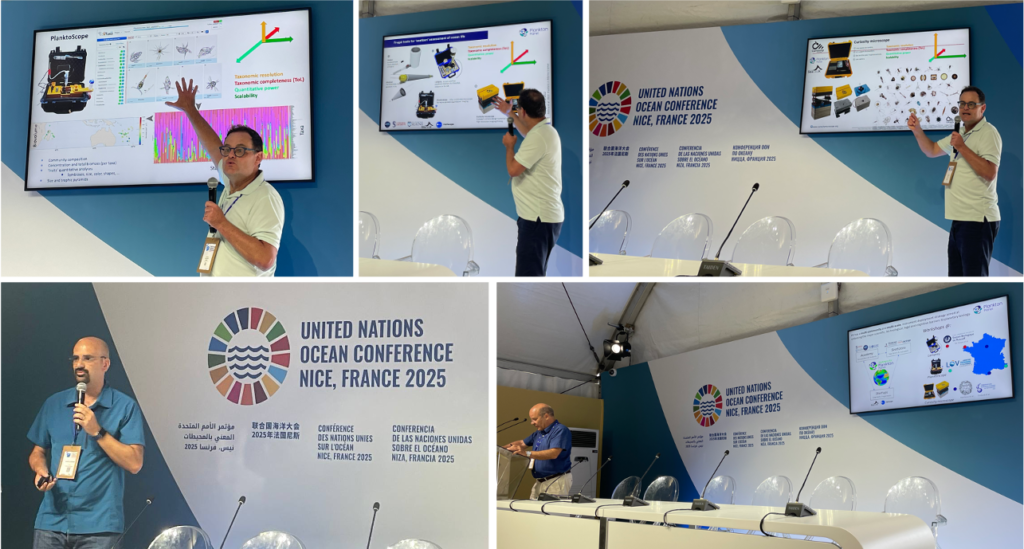 Cooperative and cost-effective planetary ocean biology, chaired by BIOcean5D scientific coordinator Colomban de Vargas at the OOSC. Credit: Fabien Lombard, Raffaele Siano.
Cooperative and cost-effective planetary ocean biology, chaired by BIOcean5D scientific coordinator Colomban de Vargas at the OOSC. Credit: Fabien Lombard, Raffaele Siano.
One recipient of BIOcean5D PlanktoScopes, Alexandra Kraberg from the Alfred Wegener Institute, provided a PlanktoScope demonstration at UNOC. Another PlanktoScope, provided by BIOcean5D to Saskia Rühl from the Plymouth Marine Laboratory, was spotted aboard the Norwegian tall ship Statsraad Lehmkuhl. The instrument had been used for plankton sampling during the Tromsø – Nice section of the One Ocean Expedition. Learn more about how the PlanktoScope is used within BIOcean5D here.
 The Norwegian tall ship Statsraad Lehmkuhl, together with a fleet of historical, scientific and oceanographic research boats from all over the world, were welcomed in the port of Nice. The PlanktoScope, provided by BIOcean5D and used for plankton sampling during the Tromsø – Nice section of the One Ocean Expedition, was spotted aboard! Another PlanktoScope provided by BIOcean5D was used for a presentation at UNOC. Credit: Fabien Lombard.
The Norwegian tall ship Statsraad Lehmkuhl, together with a fleet of historical, scientific and oceanographic research boats from all over the world, were welcomed in the port of Nice. The PlanktoScope, provided by BIOcean5D and used for plankton sampling during the Tromsø – Nice section of the One Ocean Expedition, was spotted aboard! Another PlanktoScope provided by BIOcean5D was used for a presentation at UNOC. Credit: Fabien Lombard.
BIOcean5D Early Career Researchers (ECR) also contributed to the OOSC. Marine Ethève, PhD student at CEFREM, University of Perpignan, presented results from sound recordings collected during the TREC – Tara Europa expedition that provide an unprecedented large-scale view of under-explored European marine forests. Biogeography of fish sounds across Europe’s Atlantic and Mediterranean coasts illustrates the potential of marine acoustics monitoring to reveal the impact of changes, such as environmental and human pressures.
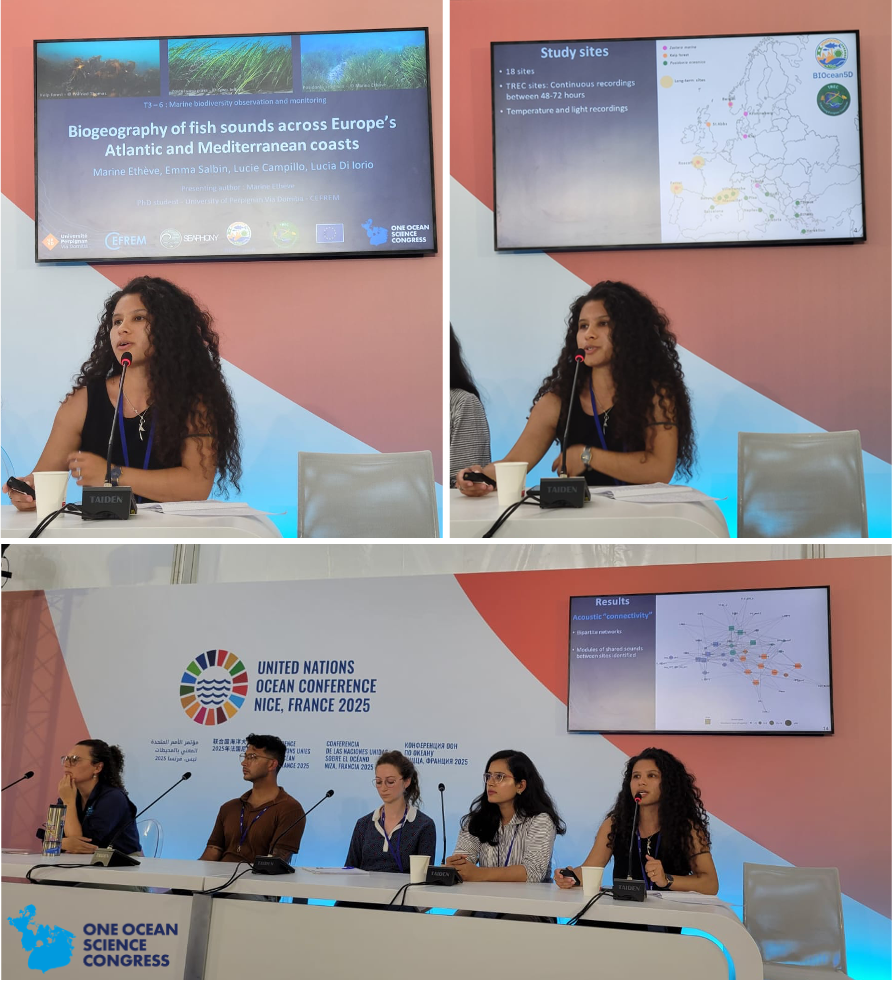 Biogeography of fish sounds across Europe’s Atlantic and Mediterranean coasts, presented by BIOcean5D researcher Marine Ethève at the OOSC. Credit: Lucia Di Iorio.
Biogeography of fish sounds across Europe’s Atlantic and Mediterranean coasts, presented by BIOcean5D researcher Marine Ethève at the OOSC. Credit: Lucia Di Iorio.
620 scientific posters were presented at La Baleine area of the OOSC, including two highlighting work by BIOcean5D researchers. The first, presented by Julián Esteban Cantillo, BIOcean5D ECR at the Institut Jean Nicod (CNRS, ENS, EHESS) – Evaluating the effectiveness of Marine Conservation Strategies: challenges for sustainable ocean management – examines different marine conservation strategies to support the development of improved adaptive and dynamic conservation tools. The second, Exclusive Economic Volumes: Enriching the palette of tools for Marine Spatial Planning by Roberto Casati, BIOcean5D researcher and director of the Institut Jean Nicod, proposes a new and precisely defined improvement to Exclusive Economic Zones (EEZ) by considering the volume of water – Exclusive Economic Volumes (EEV) – rather than the current spatial extent at surface level.
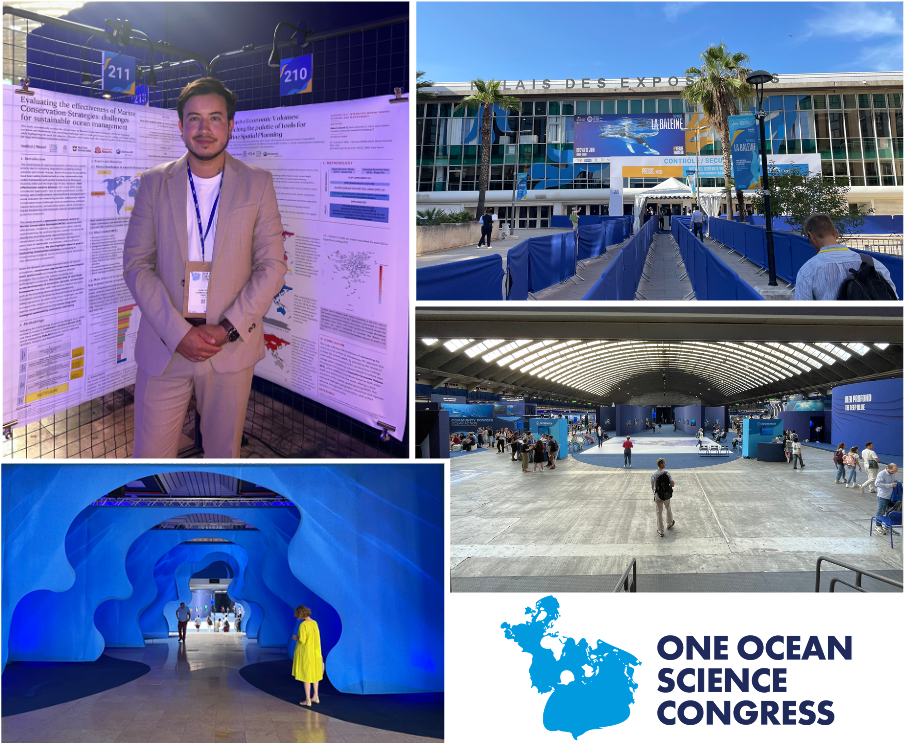 Two posters were presented at La Baleine area of the OOSC by BIOcean5D researchers Julián Esteban Cantillo and Roberto Casati. Credit: Fabien Lombard, Julián Esteban Cantillo.
Two posters were presented at La Baleine area of the OOSC by BIOcean5D researchers Julián Esteban Cantillo and Roberto Casati. Credit: Fabien Lombard, Julián Esteban Cantillo.
OOSC recommendations
Ten actionable recommendations were agreed upon during the OOSC to guide concrete political action at UNOC3.

UNOC outcome: the Nice Ocean Action Plan
The five days of high-level discussions and negotiations at UNOC3 closed with major advances and commitments that demonstrate a strong collective dynamic to protect our Ocean through revived international cooperation, coordination and collective action.
“We close this historic week not just with hope, but with concrete commitment, clear direction, and undeniable momentum”
Li Junhua, UN Under-Secretary-General for Economic and Social Affairs and Secretary-General of the summit 1
One key outcome is renewed support for the BBNJ Treaty, the first international legally binding agreement to protect biodiversity in the high seas. The Treaty was ratified by 19 countries during UNOC, bringing the current total number of ratifications to 50. With an additional 5 ratifications in progress and commitments from 12 States to ratify by September, it is hoped the 60 ratifications needed will be reached before the UN General Assembly in September, for an entry into force at the beginning of 2026. Read more about the BBNJ Treaty and how BIOcean5D is working to support its implementation here.
Further outcomes included renewed commitment for an ambitious global treaty to reduce plastic pollution and concrete announcements to move closer to the 30×30 target of 30% Marine Protected Areas (MPAs) by 2030. Calls to halt deep-sea mining are also growing, with 37 countries now supporting a precautionary pause or outright ban, with an additional ratification of the World Trade Organisation (WTO) agreement against subsidies for destructive fishing techniques, expected to come into force at the end of 2025.
European Ocean Pact
During UNOC, the comprehensive strategy that brings together EU Ocean policies and actions under one single and coordinated framework, was announced by President von der Leyen. With an investment of €1 billion, the European Ocean Pact will support ocean conservation, science and sustainable fishing to protect marine life and strengthen the blue economy through a collaborative approach involving all EU countries, regions and stakeholders.
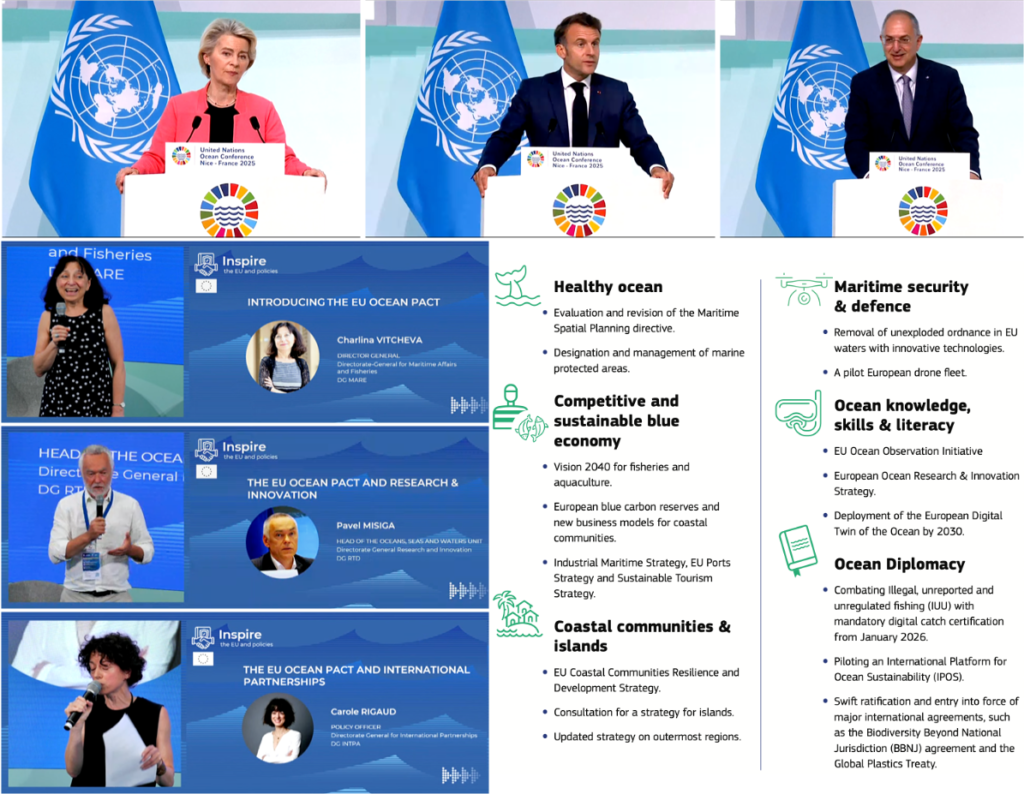
Citizen engagement
The Sciences-Sur-Mer Festival, held the 7-13 June, brought the global conversation about our Ocean during the OOSC and UNOC to the general public in Villefranche-sur-Mer, thanks to collaboration between the Institut de la Mer de Villefranche marine station and the Mairie de Villefranche-sur-Mer. BIOcean5D researchers supported open-to-all events, including conferences, workshops, debates and creative experiences, designed to link science and society through a celebration of knowledge, curiosity and a shared commitment to our Ocean.
The Becoming Ocean: a social conversation about the Ocean exhibition – open from the 8 May to 24 August 2025 at the Villa Arson, Nice – explores through art the main challenges facing the Ocean. The exhibition features two artists – Robertina Šebjanič and Laure Winants – from the BIOcean5D artists-in-residence program that welcomed artists aboard the scientific schooner Tara and at European Marine Biological Resource Centre (EMBRC) stations across Europe during the TREC – Tara Europa expedition, thanks to close collaboration between BIOcean5D, the Tara Ocean Foundation and the EMBRC. Meet and discover the work of all eight BIOcean5D artists here.
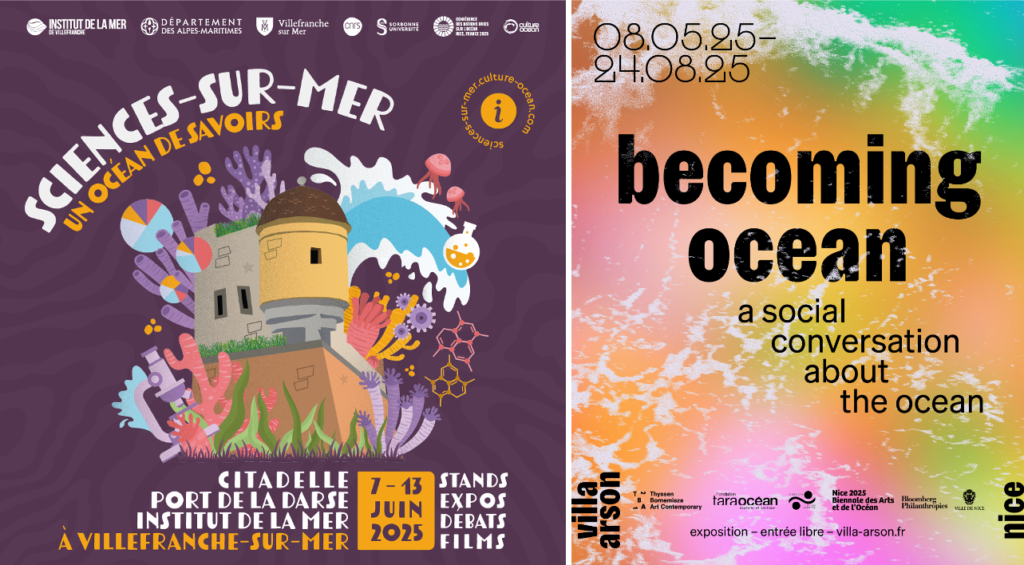
From negotiation to implementation
UNOC3, together with side events dedicated to science and citizen engagement, concludes with considerable progress achieved for Ocean protection and conservation. Now, the decisions must be transformed into action.
“It’s not so much what happens at the conference, it is what happens afterwards”
Peter Thomson, UN Special Envoy for the Ocean2